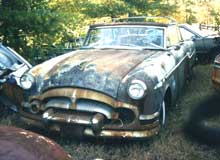A Packard for Every Purse and Purpose
We've posted at the CarPort before about Packard's postwar price point problem (yoiks, sorry for the aggravated alliteration). Indeed, the Clipper, which competed with the Buick Super, might have fared better if further differentiated from the big Packards, but the upper end of the range had identity problems of its own.
In the "Pregnant Elephant" era (1948-50), the series identities were easily understood - Eight, Super Eight, Custom Eight - even if the cars looked too much the same. But for 1951 and 1952 (the major difference was in the hood ornament), those heritage labels were thrown away and the series given numbers instead. The low-end car was called the "200," a mid-range sedan badged "300," and at the top the 400 Patrician, also a sedan. The 200 had a 122-inch wheelbase and 288 cid L-head straight eight. The 300 and 400 were both on 127 inch wheelbases, powered by a 327 cid straight eight. In between was a series 250, which had the short wheelbase and the large engine, and came as a Mayfair hardtop and convertible only. There was no 250 sedan. Pricewise, the 200 competed with the Buick Special, the 250 and 300 with the Buick Roadmaster, and the 400 Patrician with the Cadillac 62.
For 1953, new president James Nance brought back the Clipper name for what had been the 200. The 250, however, lost its series name and was known only by its catalog number, 2631. Added to the Mayfair and convertible was the new Caribbean softop, a prestige car selling for $5210 and having little in common with its fellow travelers. The Caribbean was perhaps inspired by a 1951 convertible given custom touches by coachbuilder Derham. The 300 became known as the Cavalier, the Patrician lost its "400" designation, and a pair of long (149-inch) wheelbase cars, a Corporation Limo and an Executive Sedan, was added at the top, built in small numbers. One problem was that the Mayfair and convertible were priced about $500 above the most costly Clipper, yet looked about the same.
This situation persisted into 1954, when the Clipper was given some unique sheet metal to differentiate it from the Patrician and other "large" Packards. The Cavalier returned and the big cars, which still had an unnamed series comprising the Pacific hardtop, convertible coupe and Caribbean, got a larger, 359 cid, nine-main-bearing engine.
For 1955, most Packards were Clippers; only three body styles, the Patrician sedan, a Four Hundred hardtop coupe and the Caribbean, were built on the 127-inch wheelbase. For 1956, the Clippers were moved further off scale, losing the Packard name (although many states registered them as such). A strange apparition appeared on the 122-inch wheelbase, the Executive line, which comprised a sedan and a hardtop and sold for the price of a Buick Roadmaster.
When 1957 rolled around, James Nance was gone and the Packards had become "Packardbakers," selling for Buick Century money. It's tempting to assign blame in hindsight. Packard's descent from prestige had many causes, but the confusing array of models from 1951 to 1956 must surely be among them. Cadillac held tightly to a regimen of 62, 60 Special and 75 throughout the period, and was rewarded with sales nearly four times Packard's by 1954. Perhaps if Packard had kept a heritage pecking order like that of the 1930s Six, One Twenty, Super Eight and Twelve, customers would have been less confused. There may well have been a Packard for every posh purse and purpose, but the patron was hard pressed to figure it out.
You'll notice we didn't mention Lincoln. That's because the 1952-55 Lincolns were not really luxury cars. Not until 1954 did Lincoln break the $4,000 mark. Until then it was strictly Buick-class.

